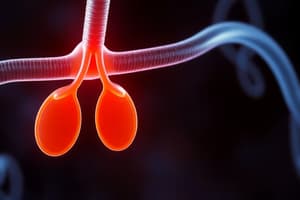Podcast
Questions and Answers
Which process involves the building of complex molecules and requires energy?
Which process involves the building of complex molecules and requires energy?
- Cellular respiration
- Anabolism (correct)
- Catabolism
- Glycolysis
What is produced during the Krebs Cycle?
What is produced during the Krebs Cycle?
- 2 NADH, 2 CO₂, and 2 Pyruvate
- 2 NADH and 2 FADH₂
- 32-34 ATP and Water
- 2 ATP, 6 NADH, 2 FADH₂, and 4 CO₂ (correct)
Where does the electron transport chain occur in the mitochondria?
Where does the electron transport chain occur in the mitochondria?
- Inner mitochondrial membrane (correct)
- Outer mitochondrial membrane
- Cytoplasm
- Mitochondrial matrix
Which of the following statements about ATP is correct?
Which of the following statements about ATP is correct?
Which statement correctly describes substrate-level phosphorylation?
Which statement correctly describes substrate-level phosphorylation?
Which product is generated during the Calvin Cycle?
Which product is generated during the Calvin Cycle?
What role does Rubisco play in photosynthesis?
What role does Rubisco play in photosynthesis?
What impact does photorespiration have on photosynthesis efficiency?
What impact does photorespiration have on photosynthesis efficiency?
Which sequence correctly describes the flow of electrons during light-dependent reactions?
Which sequence correctly describes the flow of electrons during light-dependent reactions?
What is the main function of the thylakoid membrane in chloroplasts?
What is the main function of the thylakoid membrane in chloroplasts?
Flashcards
Anabolism
Anabolism
The process of building complex molecules from simpler ones, requiring energy (endergonic), such as synthesizing proteins from amino acids.
Catabolism
Catabolism
The process of breaking down complex molecules into simpler ones, releasing energy (exergonic), such as breaking down glucose during cellular respiration.
ATP (Adenosine Triphosphate)
ATP (Adenosine Triphosphate)
The primary energy carrier in cells, composed of adenine, ribose, and three phosphate groups. Energy is released when the bond of the last phosphate group is broken, forming ADP and inorganic phosphate.
Glycolysis
Glycolysis
Signup and view all the flashcards
Electron Transport Chain (ETC)
Electron Transport Chain (ETC)
Signup and view all the flashcards
What are the two main stages of photosynthesis and where do they take place?
What are the two main stages of photosynthesis and where do they take place?
Signup and view all the flashcards
What is the role of Photosystem II (PSII) in photosynthesis?
What is the role of Photosystem II (PSII) in photosynthesis?
Signup and view all the flashcards
What does the enzyme Rubisco do in photosynthesis?
What does the enzyme Rubisco do in photosynthesis?
Signup and view all the flashcards
What is photorespiration and why is it detrimental to photosynthesis?
What is photorespiration and why is it detrimental to photosynthesis?
Signup and view all the flashcards
Describe the flow of electrons in the light-dependent reactions.
Describe the flow of electrons in the light-dependent reactions.
Signup and view all the flashcards
Study Notes
Cellular Respiration
-
Anabolism vs. Catabolism:
- Anabolism builds complex molecules from simpler ones, requiring energy. Examples include protein synthesis.
- Catabolism breaks down complex molecules into simpler ones, releasing energy. Cellular respiration is an example.
-
Energy Forms:
- Kinetic energy is energy of motion (like molecular movement).
- Potential energy is stored energy (like energy in chemical bonds).
- Chemical energy is potential energy stored in molecules like glucose or ATP.
-
ATP Structure and Function:
- ATP (Adenosine Triphosphate) is a primary energy carrier.
- It has adenine, ribose, and three phosphate groups with high-energy bonds.
- Breaking a phosphate bond releases energy, forming ADP (Adenosine Diphosphate) and inorganic phosphate (Pi). ATP is unstable and thus not stored long-term.
-
Cellular Respiration Steps:
- Glycolysis (cytoplasm): Glucose is broken down to 2 pyruvate, producing 2 ATP and 2 NADH.
- Pyruvate Oxidation (mitochondrial matrix): Pyruvate is converted to Acetyl-CoA, releasing CO₂ and producing NADH.
- Krebs Cycle (mitochondrial matrix): Acetyl-CoA is further broken down, generating CO₂, ATP, NADH, and FADH₂.
- Electron Transport Chain (ETC, inner mitochondrial membrane): Electrons from NADH and FADH₂ are passed through protein complexes. This creates a proton gradient used by ATP synthase to produce 32-34 ATP. Water is a product.
-
Products of Each Step:
- Glycolysis: 2 ATP, 2 NADH, 2 Pyruvate
- Pyruvate Oxidation: 2 NADH, 2 CO₂
- Krebs Cycle: 2 ATP, 6 NADH, 2 FADH₂, 4 CO₂
- ETC: 32-34 ATP, H₂O
-
Substrate-Level Phosphorylation:
- ATP is directly formed by transferring a phosphate group from a molecule to ADP.
- Occurs in Glycolysis and the Krebs Cycle
-
Mitochondrial Events:
- Matrix: Pyruvate oxidation and Krebs cycle take place here.
- Inner Membrane: The ETC and ATP synthesis occur in the inner membrane.
-
Specific ATP NADH, Water, and CO2 Production by Stages:
- Specific results are noted with quantities of CO2, H2O, ATP and NADH produced in each step
Photosynthesis
-
Light-Dependent and Calvin Cycle Products:
- Light-Dependent Reactions (Thylakoid Membrane): Produce ATP, NADPH, and O₂.
- Calvin Cycle (Stroma): Produces glucose.
-
Photosystems: -Photosystem II (PSII) absorbs light, splits water, realizing oxygen and electrons.
- Photosystem I (PSI) absorbs light and generates NADPH.
-
Electron Flow (Light-Dependent):
- Light excites electrons in PSII.
- Electron transport chain from PSII to PSI creates a proton gradient for ATP production.
- PSI re-energizes electrons to reduce NADP⁺ to NADPH.
-
Rubisco:
- Rubisco is a crucial enzyme in the Calvin Cycle.
- Fixes CO₂ for glucose production though it is slow.
-
Photosynthesis Efficiency:
- Only 1-2% of light energy is transformed into chemical energy.
- Photorespiration (Rubisco reacting with O2 instead of CO2) lowers efficiency.
-
Chloroplast Events:
- Thylakoid Membrane: Light-dependent reactions occur generating ATP and NADPH.
- Stroma: Calvin Cycle utilizing ATP and NADPH to form glucose.
-
Chloroplast Structure:
- Labelled structures include the outer membrane, inner membrane, thylakoids (in stacks called grana), and stroma.
Studying That Suits You
Use AI to generate personalized quizzes and flashcards to suit your learning preferences.




